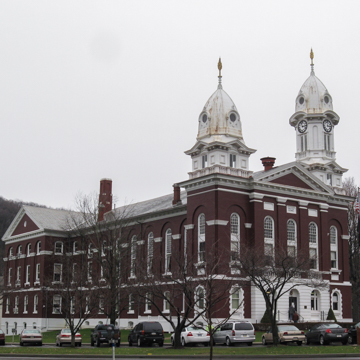Construction on the courthouse began in 1867 to a design by Samuel Sloan, who launched his career in 1849 in eastern Pennsylvania and became famous for his architectural pattern books. In 1864, he formed a partnership with Addison Hutton. They won the Clinton County Courthouse commission in Lock Haven ( CN1), which, with Sloan's courthouse of 1860 in Williamsport, Lycoming County, served as models for the Venango courthouse. The Clinton and Venango courthouses are almost identical. Their tall, narrow, ogeedomed bell towers are mirror images, the shorter tower to the left in Franklin and to the right in Lock Haven. The architects used brick, elongated round-arched windows and pedimented entrance pavilions to contrast with the asymmetrical towers. This departure from symmetry showed that the restrained Greek Revival style would no longer suffice for houses of justice. On the interior, a divided staircase behind the front wall accesses the two courtrooms, a larger courtroom with a grand, coffered ceiling and a smaller courtroom near the law library.
You are here
Venango County Courthouse
If SAH Archipedia has been useful to you, please consider supporting it.
SAH Archipedia tells the story of the United States through its buildings, landscapes, and cities. This freely available resource empowers the public with authoritative knowledge that deepens their understanding and appreciation of the built environment. But the Society of Architectural Historians, which created SAH Archipedia with University of Virginia Press, needs your support to maintain the high-caliber research, writing, photography, cartography, editing, design, and programming that make SAH Archipedia a trusted online resource available to all who value the history of place, heritage tourism, and learning.















